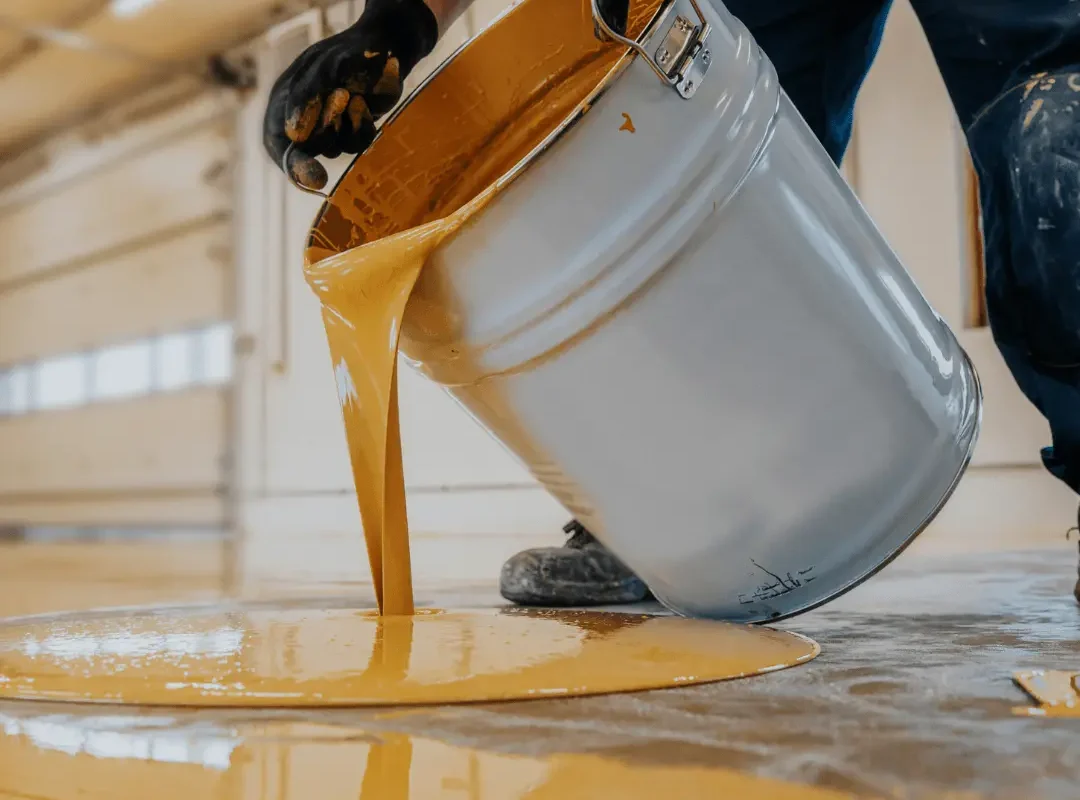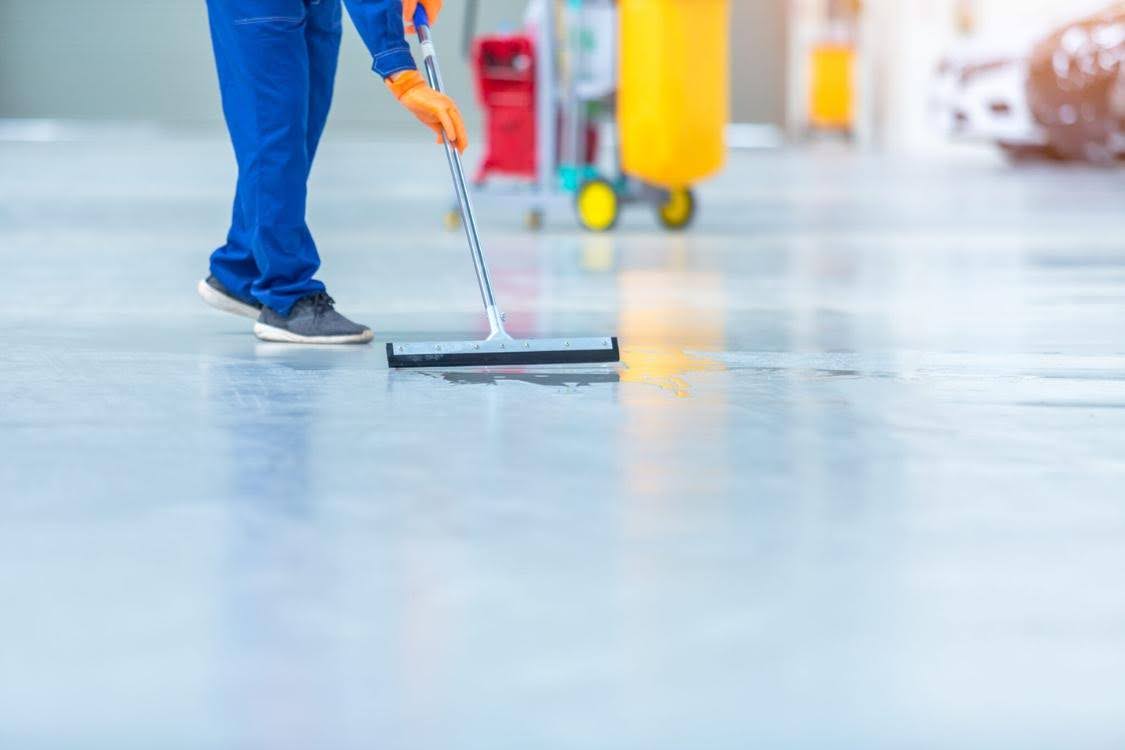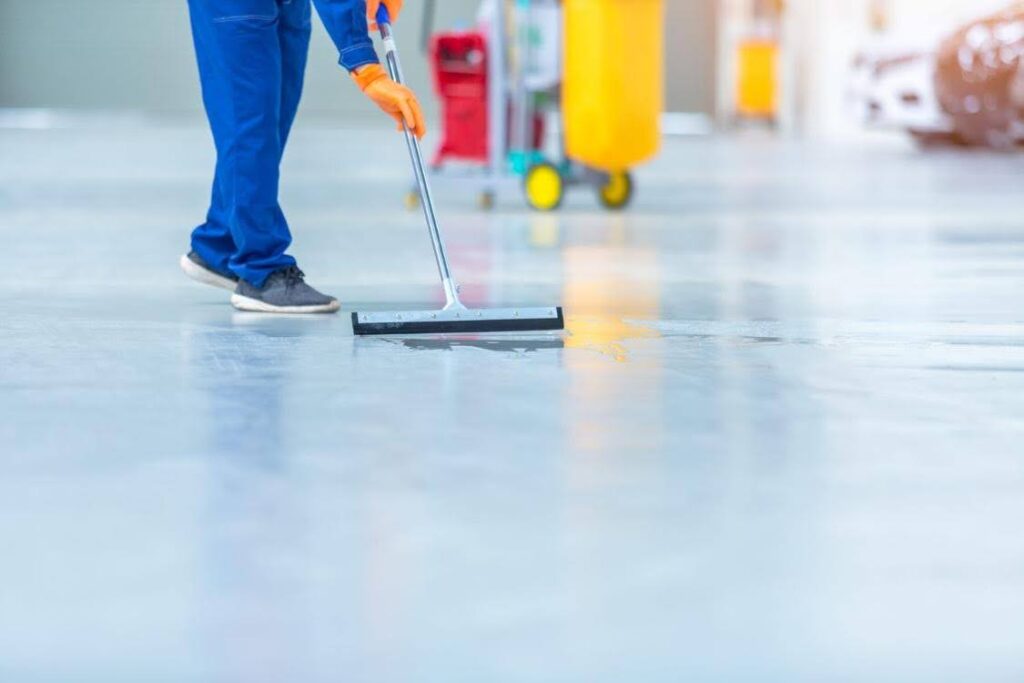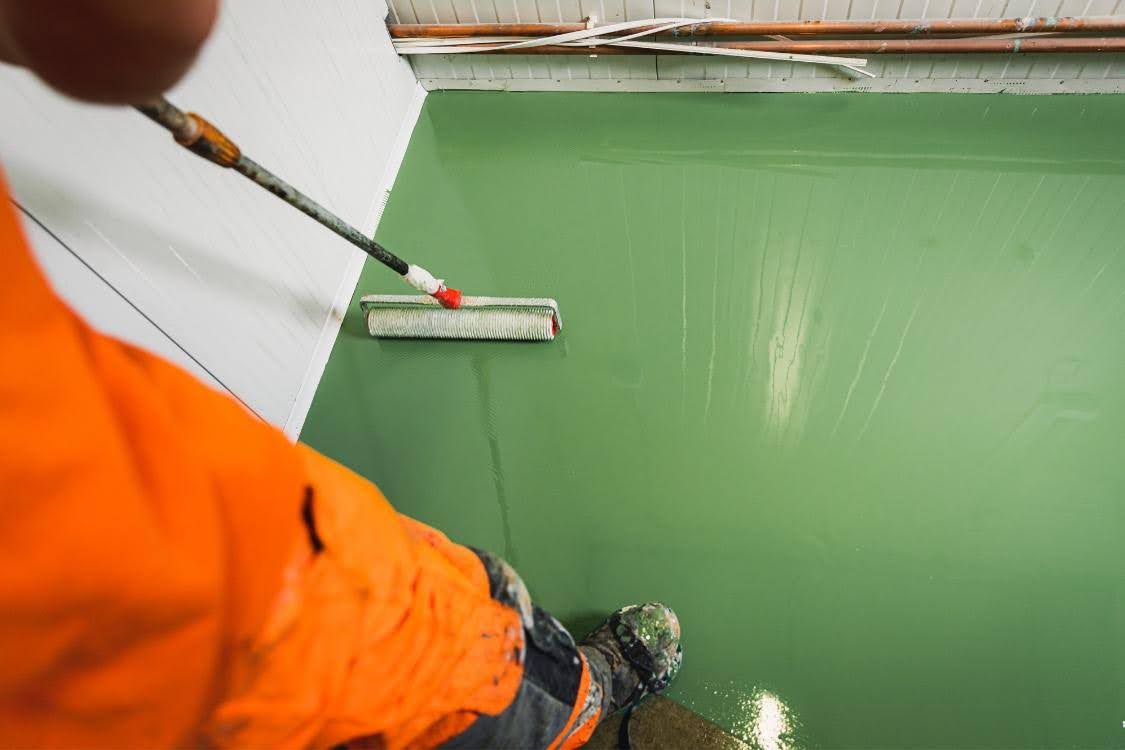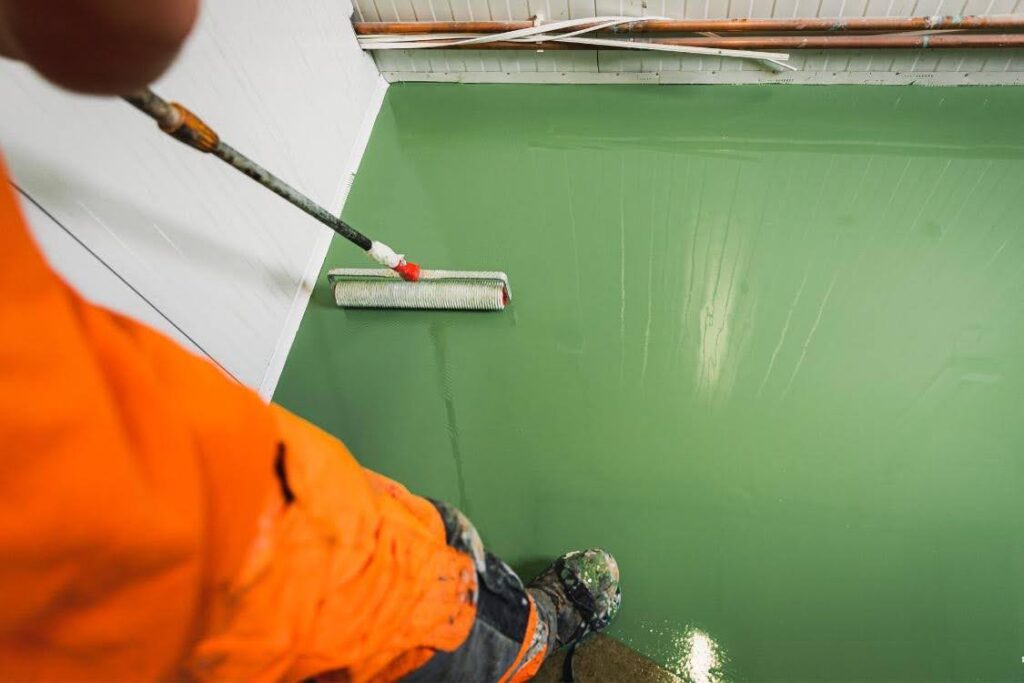
Michael Thompson
October 2, 2024
Table of Contents

Low VOC (volatile organic compound) epoxy flooring has become a popular choice for modern environments. These floors offer the durability of traditional epoxy but with a significant reduction in harmful emissions. They create safer spaces in homes, schools, offices, and hospitals. This shift aligns with the increasing demand for eco-friendly solutions that support well-being.
Low VOC epoxy flooring is made possible by recent technological advances in resin chemistry. Manufacturers have developed formulas with fewer solvents, resulting in lower emissions. Improved curing agents also allow for a quicker curing process. Thus, reducing airborne pollutants during application. In addition, advancements in polymer technology ensure that the flooring remains robust and provides protection against wear without compromising environmental safety.
By adopting low VOC epoxy flooring, spaces can maintain the high performance expected from traditional epoxy while safeguarding occupants’ health and reducing environmental impact. Whether it’s a bustling office or a medical facility, these floors create a clean, safe foundation for the people who rely on them daily.
Want to learn more about how low VOC epoxy flooring can benefit your space? Continue reading for a deeper understanding of the technology and safety features that make it a modern must-have.
Defining Low VOC Epoxy Flooring
VOCs are chemicals that can easily become moisture vapors or gases, often contributing to indoor air pollution. Low VOC epoxy is formulated to emit fewer of these compounds, creating a healthier indoor environment.
For a product to be considered low VOC, it must adhere to strict regulations and standards set by environmental organizations. This means it releases VOCs below the prescribed limits, reducing potential health risks. Low VOC epoxy flooring is important for indoor spaces like offices, homes, and healthcare facilities because it:
- helps improve air quality
- minimizes the risk of respiratory issues
- creates a more comfortable environment overall
This flooring type also has the added benefit of having a durable protective coating and harsh chemical resistance. Because of these, it is a practical choice for many applications.
VOC Exposure and Its Impact on Human Health
VOCs are chemicals found in an array of products like paints, cleaning agents, and adhesives. When present in high concentrations, they can cause significant health issues. Short-term exposure to elevated levels of VOCs can lead to symptoms like:
- headaches
- dizziness
- nausea
- eye, nose, and throat irritation
People with asthma may experience worsened symptoms due to VOCs.
Long-term exposure to high VOC concentrations can have more severe effects, including liver or kidney damage, respiratory issues, and even cancer, depending on the specific VOC involved.
For instance, formaldehyde, a common VOC, has been classified as a human carcinogen. It is crucial for individuals to ensure proper ventilation when using VOC-containing products and to seek out low-VOC or VOC-free alternatives where possible.
Health Advantages of Low VOC Epoxy Flooring
Low VOC epoxy flooring offers a variety of reasons and health benefits. These include:
- Indoor Air Quality: It emits fewer VOCs compared to traditional flooring, leading to improved indoor air quality. People with asthma or allergies can breathe easier because the low VOC levels reduce airborne irritants that could trigger symptoms.
- Minimizes Strong Odors: Low VOC epoxy flooring minimizes exposure to strong odors and harmful substances often associated with higher VOC products.
- Non-porous surface: The non-porous, smooth surface of epoxy flooring resists mold and mildew growth. They help reduce allergies and respiratory issues.
- Ease of Maintenance: This flooring is also easy to clean, preventing dust buildup that could worsen asthma symptoms.
By providing a safer, cleaner environment, low VOC epoxy flooring contributes to overall well-being, especially for individuals sensitive to airborne pollutants.
Safety Benefits in High-Traffic Areas in Commercial and Industrial Applications
In high-traffic areas like public walkways, commercial spaces, or busy warehouse floors, safety is a top priority. Slip-resistant surfaces provide crucial traction, reducing the risk of accidental falls even when the floor is wet. This enhanced grip minimizes slipping hazards, keeping everyone steady on their feet.
Impact-resistant materials also play a vital role by cushioning against drops, collisions, heavy loads, and heavy or light traffic, preventing hairline cracks or damage that could pose tripping risks. Together, these properties create a safer environment where people can move confidently and quickly, reducing accidents and ensuring smooth operations.
Environmental Impact Analysis
Low VOC epoxy flooring reduces carbon emissions and minimizes indoor air pollution. This reduction is crucial because traditional flooring options often release high levels of VOCs. Materials like carpets contribute to poor indoor air quality and environmental pollution.
By choosing low-VOC flooring, homes and companies can lower their carbon footprint. Low-VOC epoxy flooring promotes healthier environments for families, employees, and clients. Additionally, fewer VOCs mean less harm to the surrounding ecosystem. Meaning, fewer pollutants enter the air, soil, and water during production and disposal.
The adoption of low VOC flooring not only aligns with eco-friendly goals but also ensures compliance with stricter air quality standards. It’s a practical step toward creating sustainable and healthier indoor spaces.
Suggested Reading: Why Retail Giants Like Walmart Choose Commercial Epoxy Flooring?
Maintaining Indoor Air Quality Post-Installation
Maintaining indoor air quality post-installation is essential for a healthy living space. Here are some effective tips:
- Regular Cleaning: Dust and allergens accumulate quickly, so it’s important to vacuum and mop epoxy floors weekly. For air vents and filters, clean or replace them as per the manufacturer’s recommendations to prevent clogs that affect airflow.
- Ventilation: Proper ventilation is key. Use exhaust fans in kitchens and bathrooms to minimize humidity and cooking odors. Opening windows when weather permits also helps refresh indoor air and reduces pollutant build-up.
- Air Purifiers: Consider using air purifiers with HEPA filters in high-traffic areas or if someone in the household has allergies. They capture fine particles that typical cleaning methods might miss.
- Houseplants: Certain houseplants like spider plants or peace lilies naturally filter the air, reducing pollutants and adding a touch of greenery.
- Humidity Control: Keep indoor humidity levels between 30-50% with a dehumidifier or humidifier, depending on your climate. Excess humidity can foster mold growth, while too little makes the air dry and uncomfortable.
Comparing Low VOC Epoxy Flooring with Other Alternatives
When comparing low VOC epoxy flooring with traditional flooring materials, several advantages stand out.
- Indoor Air Quality: Unlike standard epoxy floor coating products or carpets, low VOC epoxy flooring improves indoor air quality. While traditional epoxy may release harmful chemicals during application, low VOC options minimize odors and reduce exposure to dangerous fumes.
- Chemical and Abrasion Resistant: Low VOC epoxy flooring offers better durability than traditional materials like hardwood or vinyl. It provides excellent resistance to heavy foot traffic, chemicals, and abrasions, making it ideal for commercial and industrial floors. Traditional wood flooring may scratch or dent easily, while vinyl can wear down over time.
- Minimal Maintenance: Cleaning low VOC epoxy floors requires simple sweeping and occasional mopping. In contrast, carpets can trap dust and allergens and require regular vacuuming and steam cleaning. Grout lines on tiled floors can accumulate dirt.
- Sustainability: Compared to other options, low VOC epoxy flooring is more environmentally friendly. Many traditional materials, like PVC-based vinyl or chemically treated hardwood, have a higher environmental impact due to the chemicals used in production. In contrast, low VOC epoxy resin minimizes chemical emissions, supporting healthier indoor spaces and reducing pollution.
- Customization: Low VOC epoxy flooring is available in a wide variety of colors, patterns, design options, and textures. This level of customization isn’t always possible with materials like tile, vinyl, or hardwood. Businesses and homeowners can create a personalized look while benefiting from the epoxy’s durability and environmental advantages.
Low VOC epoxy flooring provides superior performance, safety, and aesthetics compared to many traditional flooring materials, making it a compelling option for those looking for a healthier and more durable flooring solution.
Suggested Reading: Can High Temperature and Humidity Affect Epoxy Floors?
Budget-Friendly Options for Low VOC Flooring
When searching for budget-friendly, low VOC flooring, epoxy flooring is an excellent option. It provides an eco-friendly, durable floor surface without breaking the bank. Here’s a guide to finding affordable, low VOC epoxy flooring and understanding its ROI.
- Finding Affordable, Low VOC Epoxy Flooring
- Supplier Research: Look for manufacturers specializing in low VOC formulations, which are often advertised as “zero VOC” or “low VOC.” Companies with a strong environmental commitment usually offer competitive pricing on their eco-friendly products.
- Bulk Purchases: If tackling a larger project, consider buying in bulk. Many suppliers offer discounts for bigger orders, helping reduce per-unit costs.
- DIY Kits: Some manufacturers provide DIY epoxy floor kits designed for a simple application, which significantly cuts installation expenses.
- Installation Costs vs. Health Benefits
- Installation Costs: On average, professional and seamless flooring installation ranges from $3 to $12 per square foot. This depends on surface preparation requirements and specific materials used.
- Long-Term Health Benefits: Low VOC epoxy minimizes harmful off-gassing, creating healthier indoor air quality. This reduction in air pollution can lead to fewer respiratory issues and better overall health for residents or workers. The impact on productivity in commercial settings or lower healthcare costs at home offers notable savings over time.
While the upfront costs may seem high compared to other materials, low VOC, quality epoxy flooring provides substantial ROI in both longevity and health benefits.
How to Choose a Contractor For Residential and Commercial Epoxy Flooring
When choosing a flooring contractor, it’s important to focus on key factors to ensure a safe and professional experience. Here’s a step-by-step guide:
- Check Experience and Credentials: Look for a contractor with a solid track record in the industry. Verify that they are properly licensed and insured.
- Prioritize Health and Safety: A trustworthy contractor will prioritize health and safety, using quality, low-VOC materials and adhering to Occupational Safety and Health Administration (OSHA) standards to maintain a secure home and workspace.
- Ask for References: Reach out to past clients to understand the quality and reliability of their work.
- Review Project Portfolio: Check the contractor’s project portfolio to gauge their expertise and see if their style aligns with your needs.
- Get Detailed Quotes: Obtain an itemized quote that clearly outlines the scope of work and potential additional costs to avoid surprises.
By following these steps, you can choose an experienced contractor who prioritizes health and safety. Apex Epoxy embodies these values, providing high-quality flooring solutions with a professional touch.
For businesses and individuals seeking healthier environments, low-VOC epoxy flooring is the perfect choice. Not only does it reduce harmful emissions, but it also offers practical benefits that improve safety and sustainability.
FAQs
Yes, many epoxy flooring products are designed to have low VOC (volatile organic compound) content. These products are formulated to emit fewer chemicals into the air, making them safer for indoor use.
Zero VOC epoxy is a type of epoxy flooring that doesn’t release any volatile organic compounds during interior or exterior application and curing. This ensures a safer, more environmentally friendly installation, especially in spaces where air quality is a priority.
Traditional epoxy flooring products can contain VOCs, which are chemicals that may evaporate into the air during indoor application. However, newer formulations, including low and zero VOC options, are available for those who need safer alternatives.
VOC-free epoxy means that the product does not release any measurable levels of volatile organic compounds. This kind of epoxy is ideal for environments with strict air quality requirements, such as hospitals or schools.
Epoxy flooring is durable and, with proper maintenance, can last 10 to 20 years or more. The lifespan can vary based on traffic, maintenance, and the specific formulation used.
Yes, some epoxy flooring products are formulated for outdoor use and can resist weather elements like UV rays and moisture. Make sure to choose a product specifically designed for exterior floor surfaces.
Epoxy works best on properly prepared surfaces, like concrete floors. It may not bond well to some materials, such as wood or floor tiles, without proper preparation.
Written By:
Michael Thompson
Michael Thompson brings a deep knowledge of polymer chemistry from his Chemical Engineering studies at Georgia Tech to the forefront of his writings. With over 20 years in the industry, his articles are rich in detail about the science behind epoxy formulations and their real-world applications, guiding professionals and DIY enthusiasts alike.
Table of Contents
Related Epoxy Flooring News

Polyurea Garage Coating Florida | Heat & Weather-Proof Floors
If your garage floor is cracking, peeling, or stained, it’s time for an upgrade that

Epoxy Kitchen Floor & Indoor Epoxy Flooring in Florida
Get a durable, easy-to-clean epoxy kitchen floor that resists heat and spills. Call now

What Makes Marble Epoxy Floors a Smart Choice
Get a marble epoxy floor with a luxury look and lasting strength. Ideal for Florida

